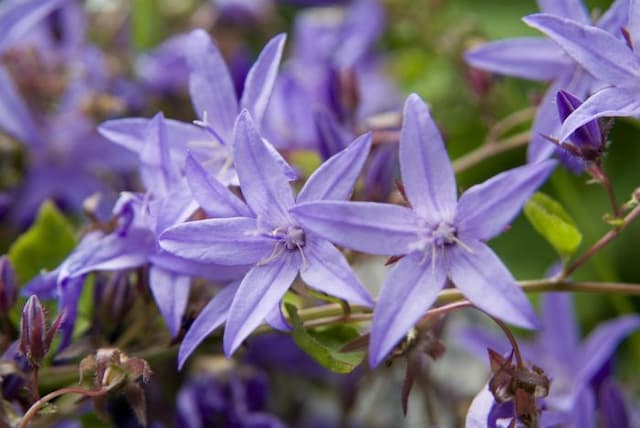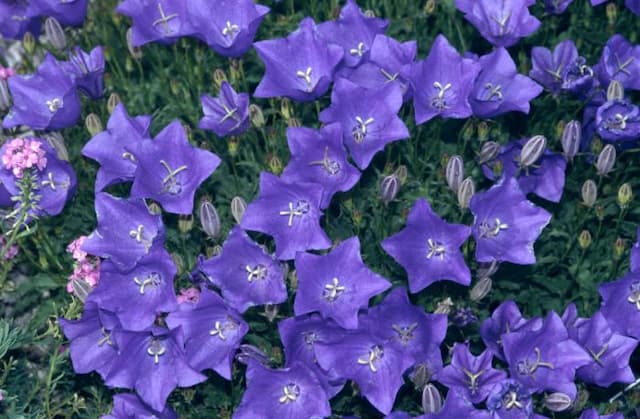Canterbury Bells Campanula medium

ABOUT
Campanula medium, known commonly as Canterbury bells, is a captivating plant known for its charming, bell-shaped flowers. These blossoms, which can be found in a range of colors such as violet, blue, pink, and white, dangle gracefully from the upper part of the plant. Each flower is composed of a fused corolla that flares at the mouth, divided into five broad lobes that give the bells their distinctive shape. The plant boasts a rosette of basal leaves which are medium green in color, with an oval to lance-shaped appearance, and are endowed with a slightly toothed margin. The leaves higher on the stem become smaller and narrower as they ascend. Canterbury bells carry their beautiful blooms on upright, sturdy stems that rise above the foliage. The stems are covered in fine hairs, giving them a somewhat fuzzy texture. The flowers are arranged in an open, loose raceme, giving each individual bloom its own space to dangle and sway in the breeze. Though the size of the plant is not the focus here, Canterbury bells have an overall stately and elegant presence in the garden. Their romantic appearance is often utilized in cottage garden settings, and they are famous for attracting pollinators such as bees and butterflies who find their blooms irresistible. The plant's structure allows for a robust display that can add a vertical element to mixed flower arrangements, both in gardens and as cut flowers in vases.
About this plant
 Names
NamesFamily
Campanulaceae
Synonyms
Canterbury Bells, Cup and Saucer, Bellflower
Common names
Campanula calycantha, Campanula carpatha, Campanula corymbifera, Campanula latifolia, Campanula macrorhiza, Campanula perfoliata, Campanula speciosa, Campanula pyramidalis, Medium grandiflorum.
 Toxicity
ToxicityTo humans
The plant commonly known as Canterbury Bells is not considered toxic to humans. It does not contain any known toxic substances that would cause harm if ingested in small quantities. However, like any plant not typically used for consumption, it may cause mild stomach upset or an allergic reaction in sensitive individuals if ingested. It is always advisable to avoid eating plants not known to be safe for consumption.
To pets
Canterbury Bells is not generally known to be toxic to pets such as cats and dogs. However, individual animals may have different sensitivities, and ingestion can sometimes lead to gastrointestinal upset, such as vomiting or diarrhea. As with humans, it is best to prevent pets from ingesting plants that are not specifically intended for them to eat. If you notice signs of distress in your pet after ingestion, you should consult a veterinarian.
 Characteristics
CharacteristicsLife cycle
Biennials
Foliage type
Deciduous
Color of leaves
Green
Flower color
Varies
Height
2-4 feet (60-120 cm)
Spread
1-2 feet (30-60 cm)
Plant type
Herb
Hardiness zones
5-8
Native area
Mediterranean
Benefits
 General Benefits
General Benefits- Attracts Pollinators: Campanula medium, commonly known as Canterbury Bells, is known to attract bees, butterflies, and other pollinating insects which are beneficial for the ecosystem.
- Aesthetic Appeal: With its tall spikes adorned with bell-shaped flowers, Canterbury Bells add visual interest and beauty to gardens and landscapes.
- Cottage Garden Style: Ideal for creating a classic cottage garden look due to its quaint and old-fashioned appearance.
- Cut Flowers: The blooms make excellent cut flowers, which can be used in floral arrangements and bouquets for their longevity and attractive form.
- Low Maintenance: Once established, Canterbury Bells are relatively low maintenance, requiring minimal care beyond basic watering and occasional feeding.
- Drought Tolerance: After establishment, they can be quite drought tolerant, making them suitable for gardens in drier climates or for gardeners seeking water-wise plants.
- Ease of Propagation: Canterbury Bells can be easily propagated from seed, allowing gardeners to perpetuate their beauty year after year.
- Variety of Colors: They come in a range of colors including blue, purple, pink, and white, which can complement a wide variety of other plants in a garden setting.
- Seasonal Charm: Offering seasonal color typically in late spring to early summer, Canterbury Bells help to bridge the gap between early spring blooms and the full flush of summer flowers.
 Medical Properties
Medical Properties- Anti-inflammatory: Campanula medium may have properties that help reduce inflammation.
- Soothing agent: The plant has been used to soothe skin irritations and minor wounds.
- Expectorant: Historically, it has been used to alleviate coughs and as an expectorant for respiratory conditions.
- Diuretic effects: There is some traditional use of the plant as a diuretic, promoting the flow of urine.
 Air-purifying Qualities
Air-purifying QualitiesThis plant is not specifically known for air purifying qualities.
 Other Uses
Other Uses- Floral Arrangements: Canterbury bells are often used in fresh bouquets and floral arrangements due to their striking bell-shaped flowers and long-lasting qualities.
- Garden Borders: The plant is commonly used to create colorful borders in gardens because of its upright growth habit and wide range of colors.
- Photography: Due to their attractive appearance, Canterbury bells are popular subjects for garden photography, often featuring in gardening magazines and online articles.
- Educational Tool: Botany enthusiasts and educators may use Canterbury bells to teach about biennial plant cycles, as they bloom in their second year after planting from seed.
- Wedding Decor: Their vibrant colors and romantic flower shape make Canterbury bells a choice for weddings, either in the ceremony décor or as part of the bridal bouquets.
- Art Inspiration: The unique structure of Canterbury bells often inspires artists and illustrators, especially those focused on botanical illustrations.
- Potted Gifts: These plants can be grown in containers, making them an ideal gift for housewarmings or as a thank-you present, especially when in bloom.
- Theme Gardens: Canterbury bells can be included in 'cottage' or 'storybook' themed gardens, enhancing an old-world charm aesthetic with their classic flower forms.
- Crafting: Dried Canterbury bells can be used in dried floral arrangements or for crafting decorative wreaths and other dried-flower crafts.
- Culinary Decoration: While not commonly used for consumption, the petals of Canterbury bells can be used as a decorative, non-toxic garnish for culinary dishes.
Interesting Facts
 Feng Shui
Feng ShuiThe Canterbury Bells is not used in Feng Shui practice.
 Zodiac Sign Compitability
Zodiac Sign CompitabilityThe Canterbury Bells is not used in astrology practice.
 Plant Symbolism
Plant Symbolism- Eternal Love: Campanula medium, commonly known as Canterbury Bells, often represents everlasting love due to their bell-shaped flowers that seem to ring with the proclamation of enduring affection.
- Gratitude: These flowers are also a symbol of gratitude, offering a way to express thanks through the grace of their blooms.
- Constancy: Canterbury Bells embody constancy and faithfulness, reflecting the steadfast nature of unwavering relationships.
- Humility: Their bell shape is reminiscent of someone bowing their head in modesty, hence they are associated with humility and reverent thought.
- Hope: The plant also signifies hope, with its ability to grow and flourish in a variety of conditions, it inspires people to remain hopeful in challenging times.
 Water
WaterFor Canterbury Bells, it's best to maintain evenly moist soil, meaning the plant should be watered thoroughly but not excessively. Water the plant with about 1 to 2 inches of water per week, ensuring that you adjust for rainfall. During hot and dry periods, additional watering may be necessary to prevent the soil from drying out completely. If you're using a container, water until you see excess water flow from the drainage holes, which indicates the soil is saturated. Ensure the plant has good drainage to avoid waterlogged conditions that can lead to root rot.
 Light
LightCanterbury Bells thrive in full sun to partial shade. They perform best when they receive at least 6 hours of direct sunlight daily, so placing them in a location that provides morning sunlight with some afternoon shade is ideal. If grown indoors, a south-facing window can provide sufficient light. In regions with very hot summers, dappled shade during the peak afternoon heat will help protect the plant from scorching.
 Temperature
TemperatureCanterbury Bells prefer a temperate range of temperatures and are hardy in USDA zones 5-8. They can withstand temperatures down to about -20 degrees Fahrenheit and up to 85 degrees Fahrenheit. The optimal growing temperature for Canterbury Bells is between 60 and 70 degrees Fahrenheit. It's important to protect the plant from extreme heat, as high temperatures can cause stress and affect blooming.
 Pruning
PruningPruning Canterbury Bells involves deadheading spent flowers to encourage additional blooming and to maintain a tidy appearance. After the main bloom in the spring or early summer, cut back the flowering stems to just above where new lateral shoots are emerging. Prune again in late summer or early fall, if necessary, to remove any yellowing leaves or stems. The best time for major pruning and shaping is immediately after the main bloom period ends.
 Cleaning
CleaningAs needed
 Soil
SoilCanterbury Bells (Campanula medium) thrive in well-draining soil rich in organic matter, with an ideal pH ranging from 6.0 to 7.5. A recommended soil mix for Canterbury Bells includes equal parts of loam, peat moss, and perlite to ensure good drainage and fertility.
 Repotting
RepottingCanterbury Bells typically do not need frequent repotting as they are biennials and often treated as annuals. Repotting every two to three years or as they outgrow their pots is sufficient to maintain plant health.
 Humidity & Misting
Humidity & MistingCanterbury Bells prefer moderate humidity levels, as too high humidity can promote fungal diseases. Aiming for a humidity level that mimics their natural outdoor environment, which could be around 40-50%, is often suitable.
 Suitable locations
Suitable locationsIndoor
Place Canterbury Bells in bright, indirect light; ensure good air circulation.
Outdoor
Plant in partial sun to light shade; protect from harsh afternoon light.
Hardiness zone
5-9 USDA
 Life cycle
Life cycleThe life cycle of Campanula medium, commonly known as Canterbury Bells, starts with seed germination, usually occurring in spring or early summer when soil temperatures are suitable. After germination, the plant enters a vegetative stage where it develops a basal rosette of leaves during the first year, investing much of its energy into root and foliage growth. In the second year, the plant enters the reproductive stage, sending up a tall stalk from the center of the rosette to flower, which typically occurs in late spring to early summer. Canterbury Bells exhibit vibrant bell-shaped flowers that can range in color from blue and purple to pink and white. After pollination, usually by bees and other insects, the plant sets seed in capsule-like fruits that, upon maturing, release seeds to complete the generational cycle. Post-seeding, the biennial Canterbury Bells plant will die, having completed its two-year life cycle.
 Propogation
PropogationPropogation time
Spring-Early Summer
The most popular method of propagation for the Canterbury Bells (Campanula medium) is by seed. Seeds are best sown in early spring, after the risk of frost has passed, or they can be started indoors about 6 to 8 weeks before the last expected spring frost. Sow the seeds thinly and barely cover them with soil, as they require light to germinate effectively. Keep the soil lightly moist until germination, which typically occurs within 14 to 21 days. Once seedlings emerge and are large enough to handle, typically with a few sets of true leaves, they can be transplanted to their final growing positions, spacing them about 12 inches (approximately 30 centimeters) apart to allow for ample growth.









